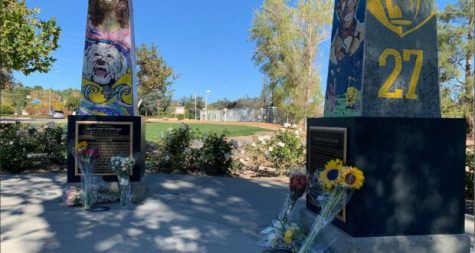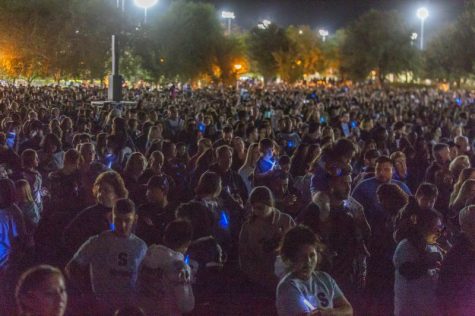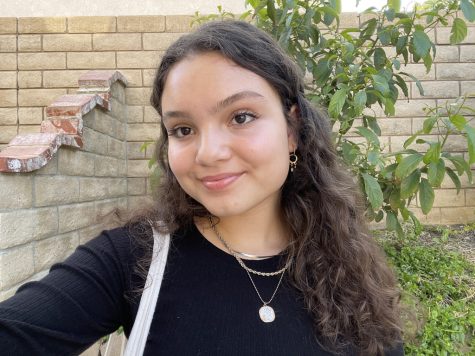Mia Tretta on Ghost Guns: the Loophole Behind the Saugus Shooting
Trigger warning: discussions of gun violence and school shootings
Good Morning Castaic's 5/2/22 Broadcast
May 6, 2022
Mia Tretta, a Junior at Saugus High School and a wounded survivor of the Saugus school shooting, spoke at the White House on April 11 to introduce President Biden’s recent action restricting ghost guns. A ghost gun was used on the morning of Nov. 14, 2019 to wound five students and kill two. A Saugus student used his father’s unserialized, self-assembled pistol to open fire, fatally wounding Dominic Blackwell, age 14, and Gracie Anne Muehlberger, age 15, before killing himself.
“Ghost guns are untraceable, build-it-yourself firearms that look like a gun, shoot like a gun, and kill like a gun, but have not been regulated like a gun,” said Mia Tretta during her speech at the White House. The President’s final rule will now treat unassembled ghost guns as if they are “real” firearms — because they are.
This new rule published in the Federal Register redefines what is considered a firearm and what the Bureau of Alcohol, Tobacco, Firearms, and Explosives, or ATF, can regulate as a firearm. The final rule clarifies that ghost gun kits, even if they are not assembled, qualify as firearms under the Gun Control Act. Regardless of whether the ghost gun was designed from a kit, individual parts, or a 3D printer, the weapon is considered a firearm under the law.
Under the final rule, ghost guns are now required to have a serial number so they can be traced back to consumers and the companies they bought them from. Additionally, commercial vendors of ghost guns must become federally licensed and run background checks on all customers. These vendors are now obligated to keep records of sales for at least 20 years.
The Daily Howl editorial board stands in support of the ban on ghost guns and regulations on firearms that have been used to terrorize and kill students in schools in the Wiliam S. Hart School District and across the nation. The Daily Howl sat down with Tretta to learn about her efforts to restrict ghost guns and prevent future incidents like the one at Saugus High School.
“When I woke up on November 14, 2019, my biggest worry of the day was a Spanish test,” said Tretta during her speech at the White House.
“After the shooting, I kind of wanted to make meaning of what happened,” said Tretta in the interview with The Daily Howl about her work as a gun safety advocate. “I didn’t know what a ghost gun was when I was a freshman at Saugus High School…After learning about what they really were, finding out that they were such a loophole in our system that no one really talked about, I knew I had to fix something.”
Biden’s final rule entails the ban on businesses manufacturing ghost guns. This includes “buy build shoot” kits — the primary vessel for ghost gun distribution. The kits allow consumers to build a gun with no trace whatsoever of the whereabouts of the gun or the entities that are associated with it. The kits include partially completed receivers or frames, which is the part of the gun involved in the firing mechanism that is exclusively regulated under federal law. However, since the weapons are uncompleted, the kits were not qualified to be regulated and serialized. The consumers were responsible for completing the finishing touches to make the gun usable. Evidently, ghost guns are a massive oversight in the Gun Control Act as people of all ages were able to purchase the unserialized unit.
As of April 11, these kits now qualify as firearms under the Gun Control Act — legislation passed in 1958 that “regulates interstate and foreign commerce in firearms, including importation, ‘prohibited persons’, and licensing provisions.” Therefore, commercial manufacturers of such kits must now serialize the product, become federally licensed, and run background checks prior to sale.
“So this is a massive step,” said Mia Tretta, regarding the final rule from the White House. “Now that he’s put this federal ban, we still need the state bans,” Tretta explains that bans on ghost guns at the state level are just as important in case the federal rules change.
“I actually helped supervisor Stefani in San Francisco put a ban on ghost guns completely and [in] San Jose and seeing those little changes are super exciting even if they don’t seem as big,” said Tretta. “The other day I testified for Los Angeles against ghost guns, putting a ban just for Los Angeles and they passed it.”
Tretta’s work locally made it possible for her to advance her efforts to the federal level. She began her work in gun safety activism after the Saugus shooting.
“I started small and local,” said Tretta regarding where her activism concerning gun violence began. “I did a lemonade stand that was donation-only to change Central Park to be in memorial of Dominic and Gracie.” Tretta also worked on training people throughout the schools, churches, and businesses in the valley on how to stop severe bleeding through Holy Cross Hospital and the Stop the Bleed program. After that, Tretta became involved with Everytown for Gun Safety, an organization dedicated to the prevention of gun violence across America. Through Everytown, Tretta was able to do her work involving local state bans on ghost guns.

While the Saugus High School incident recently shed light upon ghost guns as a massive flaw in the gun-control system, preceding incidents of ghost gun brutality are weaved into America’s repertoire of gun violence.
“Buy build shoot” kits have existed since the 1900s, but the market gained traction in 2009 when firearm manufacturers in California began searching for ways to bypass California’s Assault Weapon Control Act.
Ghost guns first became recognized as a federal issue in 2013, when a shooter opened fire at a community college in Santa Monica, California using a homemade rifle. The shooter had previously attempted to purchase a registered gun but failed his background check several times. Six people were killed, including the gunman, and four others were injured.
On Nov. 13, 2017, in Northern California, a gunman prohibited from possessing a firearm initiated a shooting rampage, killing his wife and four others — including victims at an elementary school in the Rancho Tehama Reserve.
On Aug. 4, 2019, a mass shooting occurred in a bar in Dayton, Ohio, killing nine people and injuring 27. The shooter used a homemade gun kit to construct a .223-caliber weapon which he used to fire 41 shots in 32 seconds.
On July 14, 2020, following the Saugus High School shooting, an individual owning a ghost gun allegedly killed two people in Snyder County, Pennsylvania. A Polymer80 9mm pistol was built by the gunman from a “buy build shoot” kit as he was prohibited from possessing weapons after an abuse order was filed against him on June 22.
The appeal of ghost guns stems from two key factors: their easy assembly and accessibility.
Kits are sold online and are relatively inexpensive. An AR-15 ghost gun kit can be purchased for as little as $345. Glock-type pistol kits with a frame run for roughly $400. Austin Murphey, a veteran reporter at The Press Democrat, discovered first-hand the undemanding purchasing process of ghost guns for a frame and completion kit for a pistol. The supplier promised that the kit would offer “everything needed to finish your own pistol like a professional, without the paperwork.”

Ghost guns are typically 80% complete when they are sold, and the consumer is responsible for completing the remaining 20%. Murphey took roughly eight hours to finish building the gun, but it can take as little as 30 minutes to construct a lethal weapon from an elementary DIY kit.
While this recent rule is a step in the right direction, Biden hesitated to ban ghost guns entirely because this would require a law to be passed by Congress; something that would likely receive pushback from members of the Republican party.
Tretta advises the opposition to gun safety legislation, and those who believe restrictions on ghost guns are not necessary, to look at it from the survivor’s perspective.
“If it was your daughter who was shot, or if it was your niece who was killed, or if you were shot, yourself, would [you] still feel that way?” asked Tretta. “And if you do still feel that way, then how can that be okay?”
The United States is an extreme global outlier when it comes to the deaths due to shootings. With a gun violence death toll 13 times higher than other developed countries, gun control is almost an exclusively American issue. The United States has had 1,316 school shootings since 1970 and 18% of this total occurred after the Sandy Hook Elementary shooting in 2012. As of 2019, firearm injury is the leading cause of death for middle and high school-age children — and school shootings are only the tip of the iceberg.
Every year, 3 million children are exposed to gun violence in the US, and ghost guns are only propelling the rate of crime. Between 2010 and April 2020, more than 2,500 ghost guns were linked to criminal activity. Roughly 40% of these cases involved defendants who were prohibited from legally owning a firearm. Plus, in California alone, 30% of guns recovered by ATF are unserialized according to a 2019 report.
“If we don’t work to make better regulations then it’s only a matter of time before it happens to everyone,” said Tretta. “It’s eventually going to affect everyone that you know and whether you think, ‘it can’t be me.’ ‘It won’t be me.’ It could be.”
Tucked away in one of the safest cities in America, Santa Clarita residents once shared a sentiment of immunity towards gun violence — specifically school shootings. However, denial could not build a wall strong enough to prevent Saugus High School – ranked in the top 12% of public high schools in the country – from ending up on the list of deadly school shootings in the US.
The school’s prestige did not guarantee the safety of the students on Nov. 14, 2019. Neither did the diligently outlined Sheriff’s Department zones — or the fact that the first responder to the scene of the shooting was parent, Daniel Finn, an off-duty LA County Sheriff Detective. The community was unwilling to entertain the idea that it could be their kids getting shot or their kids picking up the gun. But this denial did not save Saugus, or the community of SCV, from the devastating reality of how gun violence shatters lives and undermines the integrity of the school system.
Thousands of people attended the Saugus High School Vigil at Central Park. The shooting ignited shock, but it also spread awareness and triggered changes within SCV and nationwide. Yet gun violence still prevails, leaving scars in its wake.

“I wanted to figure out a way to help myself and make sure that it doesn’t happen to anyone else,” said Tretta. “I know how it feels when it happened to me and I don’t want anyone else to feel that way.”
One area that divides people when it comes to gun safety legislation is the 2nd Amendment. Opponents argue they have a Constitutional right to own a gun and resist any form of regulation on that right—even when the laws are meant to ensure that guns are only in the hands of those who can own them responsibly.
“I think a lot of people think ‘oh she just wants to take all of our guns, she wants to get rid of 2A’…That’s not true,” said Tretta, referencing the misconstrued belief that she, and other gun safety advocates, want to abolish the second amendment. “It’s just gun safety: locking up your guns if you’re going to have them, serializing them, getting a background check, because, truly, if you are just a gun hobbyist, if you just want your guns, then you should be able to do all of these safety protocols.”
Even though Biden’s recent rule addressed a technicality — all ghost guns currently in the manufacturing process, or a part of store inventory or stock, must be given a serial number — one loophole remains: what happens to the ghost guns already in the public’s possession? Are people in possession of 3D printers still able to print ghost guns without regulation? Owners of these lethal weapons are able to keep and make these firearms without any consequences, and the government has no ability to trace them whatsoever.
Due to most legislation targeting the “buy build shoot” kits and their manufacturers, 3D-printed ghost guns are now the more desirable option as they seem to be the remaining shortcoming to the impressive regulations cracking down on ghost guns. An alarming concern is the affordability of 3D printers as most of them sell for around $200, so it’s not just mechanical engineers who can build a gun.
“In the past decade, jigs and templates have become available that make finishing these aluminum or polymer castings much simpler,” states a report from the Congressional Research Service. Via templates, guns can be printed with minimal knowledge or skill, making it a craft for everyday people. Essentially, the more accessible 3D printing becomes, the more available ghost guns become. Although, even with the assistance of a template, creating a gun via 3D printing isn’t simply printing a gun. Only the several different parts, most of which are located in the chassis (or lower receiver) of the weapon, can be printed. The remainder of the parts needed to craft the weapon will then be purchased. However, these parts, such as metal barrels, require no background checks.
“Ghost guns, not only are they untraceable and they don’t have a background check and anyone can buy them, but they’re just growing and it’s become an epidemic,” said Tretta. And they have. With over 20,000 ghost guns currently in circulation, the fight for keeping people safe from gun violence is as critical as ever.
“I mean Students Demand Action is so easy to get involved with,” said Tretta. “I would totally help anyone who wants to start a group, wants to join my group, or wants to join their school’s group.”
If you or someone you know would like to get involved in gun safety advocacy, then Students Demand Action, a program created by Everytown for Gun Safety, is a way for students to be involved in the effort to stop gun violence. Students can join or create “groups” that act as community chapters and together fight against the use of firearms. These groups consist of student volunteers who actively campaign for the prevention of gun violence by registering voters and creating firearm storage awareness policies in educational settings.
For more information on this grassroots organization, you can visit studentsdemandaction.org or contact [email protected]. Starting a new group will involve selecting a leader to complete a group application, filling out the volunteer agreement and parent consent forms, and then receiving an approval email. Tretta explains that another way to be a part of the solution to gun violence is through education.
“Just learning,” said Tretta, when asked about how students can help. “Say someone is just like ‘I didn’t know they weren’t trying to take guns’ or ‘I didn’t know it was just about safety.’ Just look into it [and] have a conversation. I’m totally here to explain things that don’t necessarily make sense because it didn’t make sense to me at one point either.”
Fifty-five school shootings have taken place this year in America, and eight people have already died. Schools are not supposed to be battlefields. Students need to have the burden of their safety lifted off their backs because the biggest worry on a student’s mind should be the Spanish test they have that day.
Hard lockdown drills, bulletproof backpacks, and goodbye texts should not be the fate of every generation of students making their way through the US school system. Change is happening, but there’s significantly more progress that needs to be made in order for students to feel safe in schools again.
Take Tretta’s advice: Listen to kids who are speaking out against gun violence. Listen to survivors, the people who have truly gone through it. Listen to them and listen to their ideas.
Vote, march, petition, and campaign so that no more yearbook pages are dedicated to students who were shot and killed on the same ground where they used to learn, laugh, and race to class before the bell rang. Because the work doesn’t end with regulations on ghost guns. The work doesn’t end with universal background checks or safe storage. Until school shootings are history, the effort must continue.
“Once you have the big victories, you can’t give up,” affirmed Tretta.
Students and survivors are struggling to keep the pressure on politicians, and it’s the trivial particulars that drown out consensus and cause gun safety legislation to bleed out on the Senate floor. Communities are exhausted from bandaging the bullet wounds that continue to besiege school campuses across the nation. They are screaming for it to stop—and it’s long past time that America starts listening.





